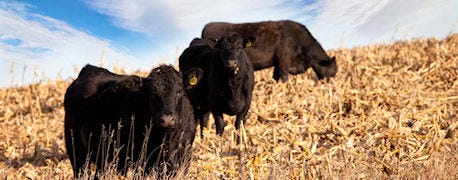August 6, 2012

Chopping corn for silage, cutting it for hay or grazing standing corn have traditionally been popular choices for management of weather-damaged crops. However, swath grazing is another viable forage option.
Bruce Anderson, extension forage specialist for the University of Nebraska, says swath grazing has some advantages over other methods of salvaging corn.
In comparison to silage and hay, less harvest equipment is needed, and timing of harvest isn't as delicate. Storage and moving isn't a factor with swath grazing, either. Anderson says when compared to grazing standing corn, swath grazing will make setting fences easier and there will be much less trampling loss.
Economics, too

Lower costs, easier harvest make swath grazing attractive method for using drought-damaged corn.
Several years back when the Center for Grassland Studies at the University of Nebraska compared costs and returns on swath grazing versus baling feeding meadow grasses, the researchers found significant advantage for swath grazing.
In 1997-1998, when forage and inputs were much cheaper, net returns for windrow grazing were $72.26 head, compared with $52.31 head for the bale-feeding strategy – a 38% savings.
Much of the difference was due to baling and bale moving costs. The cost of feeding is a major addition to the bale-fed strategy at $11 ton. By comparison the costs for windrow grazing are for fencing materials and labor to install the fence and move the temporary fence.
Calculated another way, feed costs totaled 16 cents per head per day for windrow grazing compared with 30 cents per head per day for bale feeding.
Make the swath
Though swath grazing is fairly simple, the hardest part is making the swath. Thick stalks can be hard to cut and feed cleanly through a swather or windrower. If you have a hay conditioner, remove it or open it as wide as possible. Otherwise, if you have any grain, much of it will be shelled from the ear, fall to the ground and be lost.
Before you start grazing, be sure to condition cattle to eating grain, otherwise selective eating may cause acidosis. Use fences to force cattle to clean up most of the swath. Not only does this stretch your feed supply, it also removes residues that could impede next spring's tillage or planting.
If you plan to salvage corn as forage, don't automatically chop silage. Consider swath grazing as an easier and cheaper alternative.
View more studies on windrow grazing from the Center for Grassland Studies at the University of Nebraska.
You May Also Like




